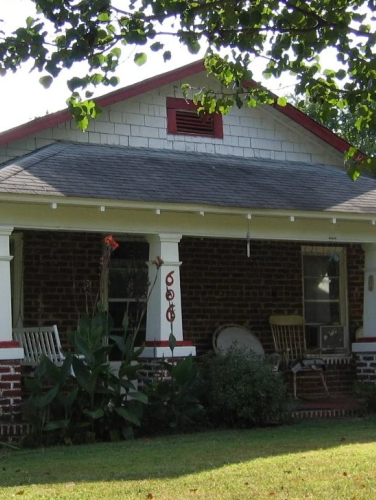
Rowland-Clay House
(ca. 1929)
The stylish Craftsman bungalow is a rare remnant of Tank Town, the late 19th century segregated town once located outside the Matthews town limits.
606 E Charles St, Matthews, NC 28105
The Rowland-Clay House is one of the last remaining houses from Tank Town (now known as Crestdale), a rural community settled in the 1860s by historically free or formerly enslaved African Americans. Dating from the 1870s, the area was called Tank Town because of the railroad water tank standing near the railroad tracks that crossed the district. Many of Tank Town’s first inhabitants were employed in operating the tank and performing other duties associated with the railroad and depot, both run by the Central Carolina Railroad Company. When the depot opened – near a stagecoach stop and post office, at a point approximately halfway between Monroe and Charlotte – it was called “Matthews” in honor of Watson Matthews, a member of the Board of Directors of the Central Carolina Railroad.
Property Quick Links
Railroad jobs were the best available option for Tank Town residents. The railroad provided steady employment, cash wages, housing, and later, insurance benefits. But those jobs were limited in number. Most African Americans living in the Tank Town and Matthews area worked as sharecroppers or day laborers, in part because few Black farmers could afford to purchase land. It is believed that the only independent farmers in Tank Town were Abelola Weddington, the mulatto daughter of a prominent white farmer in the area, and her husband Green Lee Stewart. Abelola and Green farmed a fifteen-acre tract owned by Abelola Weddington until they lost the land upon a crop lien foreclosure.
In 1929, Charlie and Vivian Rowland purchased six acres of land in Tank Town for $100. Charlie was employed by the railroad. Although his actual job remains unknown, Charlie’s income was sufficient to allow him to build a relatively stylish brick Craftsman-style bungalow for his family, the only such house in that community from that era. The Craftsman style was a popular architectural style at that time, but very few of the Rowlands’ Tank Town neighbors built such homes. Instead, 19th century housing for rural tenant farmers like those in Tank Town usually consisted of the more simplistic two-room hall-and parlor style. After the turn of the century, rural African American communities started to build larger one-story, four-room houses, focusing primarily on functionality as opposed to specific architectural styles, making the Rowland-Clay House all the more unique.
Odell and Allie Clay purchased the house in 1951, where they raised their five children. It was the first house that the family owned, purchased after the family stopped sharecropping for the Funderburks, a prominent Matthews family that owned a general store, livery stable, and operated the Bank of Matthews. After moving into their new home, Odell began working in construction, while Allie was employed at East Mecklenburg High School, providing the steady and relatively high wages that allowed them to buy the home. The Rowland-Clay House stands as an important remnant of a rural community and way of life that no longer exists in Mecklenburg County, making the house a valuable reminder of early 20th century life in Mecklenburg County.

